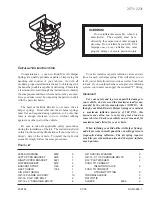
160
Vehicle care
Driving with a damaged tyre
A loss in tyre pressure is indicated by
the deflation detection system.
If a tyre has no pressure, continued
driving is possible
■ at a speed of max. 80 km/h
(50 mph)
■ up to a distance of 80 km
(50 miles)
9
Warning
The vehicle will be more difficult to
steer and handle. Braking
distance will be longer.
Adapt driving style and speed to
the changed conditions.
Tyre designations
E.g. 185/65 R 15 88 T
185 = Tyre width, mm
65 = Cross-section ratio (tyre
height to tyre width), %
R
= Belt type: Radial
RF = Type: RunFlat
15 = Wheel diameter, inches
88 = Load index e.g. 88 is
equivalent to 567 kg
T
= Speed code letter
Speed code letter:
Q = up to 160 km/h (100 mph)
S = up to 180 km/h (112 mph)
T = up to 190 km/h (118 mph)
H = up to 210 km/h (130 mph)
V = up to 240 km/h (150 mph)
W = up to 270 km/h (168 mph)
Tyre pressure
Check the pressure of cold tyres at
least every 14 days and before any
long journey. Do not forget the spare
wheel. This also applies to vehicles
with tyre pressure monitoring system.
Remove the valve cap key from the
fuel filler flap and use it to unscrew the
valve cap.
Tyre pressure
3
198 and on the label
on the inside of the fuel filler flap, if
present.
The tyre pressure data refers to cold
tyres. It applies to summer and winter
tyres.
Always inflate the spare tyre to the
pressure specified for full load.
The ECO tyre pressure serves to
achieve the smallest amount of fuel
consumption possible.
Incorrect tyre pressures will impair
safety, vehicle handling, comfort and
fuel economy and will increase tyre
wear.
Summary of Contents for 2009 Corsa
Page 3: ...2 Introduction Introduction ...
Page 6: ...Introduction 5 ...
Page 11: ...10 In brief Instrument panel overview ...
Page 13: ...12 In brief ...
Page 76: ...Instruments and controls 75 Control indicators in the instrument cluster ...
Page 205: ...204 Technical data Towing hitch installation dimensions ...
Page 211: ...210 ...
















































